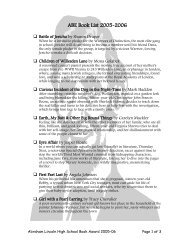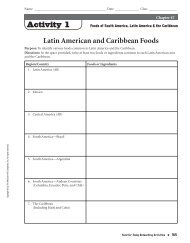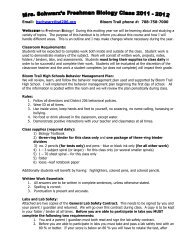Teen Dating Violence Facts - Bloom Trail High School
Teen Dating Violence Facts - Bloom Trail High School
Teen Dating Violence Facts - Bloom Trail High School
Create successful ePaper yourself
Turn your PDF publications into a flip-book with our unique Google optimized e-Paper software.
■ A University of Texas medical center study of new mothers, age 18 and younger, chronicled<br />
numerous reports of being slapped, hit, kicked or physically hurt by a husband or boyfriend.<br />
Most of the violent incidents occurred during the first three months after childbirth.<br />
S. Harrykissoon, M.P.H., V. Rickert, Psy.D. and C. Wiemann, Ph.D, (2002).<br />
■ Both victims and abusers attribute the responsibility for violent dating behavior to victims,<br />
caused by: provocation by the girl; the victim’s personality type; the girl’s need for affection;<br />
communication problems; and peer group influence.<br />
Francine Lavoie et Al, <strong>Teen</strong> <strong>Dating</strong> Relationships and Aggression, (2002).<br />
■ 77% of female and 67% of male high school students endorse some form of sexual coercion,<br />
including unwanted kissing, hugging, genital contact, and sexual intercourse.<br />
M. Jackson, F. Cram & F.W. Seymour, Journal of Family <strong>Violence</strong>, (2000).<br />
■ Male peer support for violence against women is a constant predictor of male violence within<br />
post-secondary educational institutions.<br />
Martin D. Schwartz & Walter S. DeKerrseredy, “Aggregation Bias and Woman Abuse,” (2000).<br />
■ 50% of youth reporting both dating violence and rape also reported attempting suicide, compared<br />
to 12.5% of non-abused girls and 5.4% of non-abused boys.<br />
D. M. Ackard, Minneapolis, MN, and D. Neumark-Sztainer, Division of Epidemiology, <strong>School</strong> of Public Health, University of<br />
Minnesota, Minneapolis, MN, “Date <strong>Violence</strong> and Date Rape Among Adolescents: Associations with Disordered Eating Behaviors and<br />
Psychological Health,” Child Abuse & Neglect, 26 455-473, (2002).<br />
THE LEGACY OF RELATIONSHIP ABUSE<br />
■ More than half of both prison and jail inmates serving time for violence against an intimate<br />
were using drugs, alcohol or both at the time of the incident for which they were incarcerated.<br />
U.S. Department of Justice, http://www.ojp.usdoj.gov/bjs/pub/press/vi.pr, (1998). (Last visited 9/04.)<br />
■ The severity of violence among intimate partners has been shown to increase if the pattern has<br />
been established in adolescence.<br />
S.L. Feld & M.A. Strauss, Criminology, 27, 141-161, (1989).<br />
■ Patterns of dating violence behavior often start early and carry through into adult<br />
relationships.<br />
V.A. Forshee et Al, Health Education Research, 11(3), 275-286, (1996).<br />
■ Violent relationships in adolescence can have serious ramifications for victims: Many will continue<br />
to be abused in their adult relationships and are at a higher risk for substance abuse, eating<br />
disorders, risky sexual behavior, and suicide.<br />
Jay G. Silverman PhD, et Al, “<strong>Dating</strong> <strong>Violence</strong> Against Adolescent Girls and Associated Substance Use, Unhealthy Weight Control,<br />
Sexual Risk Behavior, Pregnancy, and Suicidality.” Journal of the American Medical Association, (2001).<br />
© 2006 American Bar Association 4 NATIIONAL TEEN DATING VIOLENCE PREVENTION INITIATIVE
















